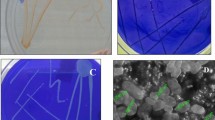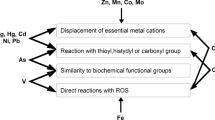Abstract
In this study, effects of antimony Sb(V) on growth, pigments content, oxygen evolution, and photosystem II (PSII) activity of Microcystis aeruginosa were investigated. JIP-test, Q −A reoxidation kinetic test and S-state test were used in this study to study the energy distribution and electron transport in PSII. Treatment with Sb(V) at various concentrations ranging from 5 to 100 mg/l had long-term effects on growth, pigments content, and oxygen evolution of M. aeruginosa. Low concentration of Sb(V) had no significant inhibition of the biomass production and PSII activity but inhibited the pigment synthesis. Growth, pigments content, oxygen evolution, and PSII activity were seriously inhibited when treated by high concentration of Sb(V) (100 mg/l). The target sites of Sb(V) toxic effect on the PSII of M. aeruginosa were mainly on the donor side and the apparatus in the light-dependent reaction. The quantum yield for photochemistry, density of reaction centers and photosynthesis performance index decreased, whereas the dissipated energy increased. PSII activity of M. aeruginosa was promoted when exposure to 50 mg/l Sb(V) by increasing the density of active reaction centers and electron transport after Q −A .







Similar content being viewed by others
References
Appenroth KJ, Stöckel J, Srivastava A, Strasser RJ (2001) Multiple effects of chromate on the photosynthetic apparatus of Spirodela polyrhiza as probed by OJIP chlorophyll a fluorescence measurements. Environ Pollut 115:49–64
Bustamante J, Lennart D, Marie V, Bruce F, Sten O (1997) The semiconductor elements arsenic and indium induce apoptosis in rat thymocytes. Toxicology 118:129–136
Chylla RA, Whitmarsh J (1989) Inactive photosystem II complexes in leaves turnover rate and quantitation. Plant Physiol 90:765–772
Council of the European Communities (1976) Council Directive 76/464/EEC of 4 May 1976 on pollution caused by certain dangerous substances discharged into the aquatic environment of the community. Official J L 129:23–29
Govindjee (1995) Sixty-three years since Kautsky: chlorophyll a fluorescence. Aust J Plant Physiol 34:1073–1079
Han T, Kang SH, Park JS, Lee HK, Brown MT (2008) Physiological responses of Ulva pertusa and U armoricana to copper exposure. Aquat Toxicol 86:176–184
He MC, Wan HY (2004) Distribution speciation toxicity and bioavailability of antimony in the environment. Prog Chem 16:131–135
He MC, Yang JR (1999) Effects of different forms of antimony on rice during the period of germination and growth and antimony concentration in rice tissue. Sci Total Environ 243(244):149–155
Hill R, Larkum AWD, Frankart C, Kühl M, Ralph PJ (2004) Loss of functional photosystem II reaction centers in zooxanthellae of corals exposed to bleaching conditions using fluorescence rise kinetics. Photosynth Res 82:59–72
International Agency for Research on Cancer (1998) http://www.inchem.org/documents/iarc/vol47/47-11.html. Accessed 6 June 2011
Jones RD (1994) Survey of antimony workers: mortality 1961–1992. Occup Environ Med 51:772–776
Krinsky NI (1989) Antioxidant function of carotenoids. Free Radical Biol Med 7:617–635
Küpper H, Šetlík I, Spiller M, Küpper FC, Prášil O (2002) Heavy metal-induced inhibition of photosynthesis: targets of in vivo heavy metal chlorophyll formation. J Phycol 38:429–441
Li L, Chen X, Zhang DY, Pan XL (2010) Effects of insecticide acetamiprid on photosystem II (PSII) activity of Synechocystis sp (FACHB-898). Pestic Biochem Physiol 98:300–304
Lichtenthaler HK, Wellburn AR (1983) Determination of total carotenoids and chlorophyll a and b of leaf extracts in different solvents. Biochem Soc Trans 603:591–592
Manes F, Donato E, Vitale M (2001) Physiological response of pinus halepensis needles under ozone and water stress conditions. Physiol Plant 113:249–257
Meharg AA (1993) The role of the plasmalemma in metal tolerance in angiosperms. Physiol Plant 88:191–198
Müller P, Li XP, Niyogi KK (2001) Non-photochemical quenching: a response to excess light energy. Plant Physiol 125:1158–1566
Paddock ML, Sagle L, Tehrani A, Beatty JT, Feher G, Okamura MY (2003) Mechanism of proton transfer inhibition by Cd2+ binding to bacterial reaction centers: determination of the pK A of functionally important histidine residues. Biochemistry 42:9626–9632
Pan XL, Deng CN, Zhang DY, Wang JL, Mu GJ, Chen Y (2008) Toxic effects of amoxicillin on the photosystem II of Synechocystis sp. characterized by a variety of in vivo chlorophyll fluorescence tests. Aquat Toxicol 89:207–213
Pan XL, Zhang DY, Chen X, Bao AM, Li LH (2010) Antimony accumulation growth performance antioxidant defense system and photosynthesis of Zea mays in response to antimony pollution in soil. Water Air Soil Pollut 215:517–523
Pan XL, Zhang DY, Chen X, Mu GJ, Li LH, Bao AM (2009) Effects of levofloxacin hydrochloride on photosystem II activity and heterogeneity of Synechocystis sp. Chemosphere 77:413–418
Pan XL, Chen X, Zhang DY, Wang JL, Deng CN, Mu GJ, Zhu HS (2009) Effect of chromium(VI) on photosystem II activity and heterogeneity of synechocystis sp. (cyanophyta): studied with in vivo chlorophyll fluorescence tests. J Phycol 45:386–394
Perales-Vela HV, Peña-Castro JM, Cañizares-Villanueva RO (2006) Heavy metal detoxification in eukaryotic microalgae. Chemosphere 64:1–10
Perales-Vela HV, González-Moreno S, Montes-Horcasitas C, Cañizares-Villanueva RO (2007) Growth photosynthetic and respiratory responses to sub-lethal copper concentrations in Scenedesmus incrassatulus (Chlorophyceae). Chemosphere 67:2274–2281
Smichowski P (2007) Antimony in the environment as a global pollutant: a review on analytical methodologies for its determination in atmospheric aerosols. Talanta 75:2–14
Stanier RY, Kunisawa R, Mandel M, Cohen-Bazire G (1971) Purification and properties of unicellular blue-green algae (order Chroococcales). Bacteriol Rev 35:171–205
Strasser BJ (1997) Donor side capacity of photosystem II probed by chlorophyll a fluorescence transients. Photosynth Res 52:147–155
Strasser BJ, Strasser RJ (1995) Measuring fast fluorescence transients to address environmental questions: the JIP-test. In: Mathis P (ed) Photosynthesis: from light to biosphere. Kluwer Academic Publishers, Dordrecht, pp 977–980
Strasser RJ, Tsimilli-Michael M, Srivastava A (2004) Analysis of the chlorophyll a fluorescence transient. In: Papageorgiou GC, Govindjee (ed) Advances in photosynthesis and respiration. Springer, Dordrecht, pp 321–362
Tripathi BN, Mehta SK, Amar A, Gaur JP (2006) Oxidative stress in Scenedesmus sp. during short- and long-term exposure to Cu2+ and Zn2+. Chemosphere 62:538–544
United States Environmental Protection Agency (1979) Water related fate of the 129 priority. Pollutants 1: 23–29
Vass I, Kirilovsky D, Etienne AL (1999) UV-B radiation-induced donor- and acceptor-side modifications of photosystem II in the cyanobacterium Synechocystis sp. PCC 6803. Biochemistry 38:12786–12794
Vrettos JS, Stone DA, Brudvig GW (2001) Quantifying the ion selectivity of the Ca2+ site in photosystem II: evidence for direct involvement of Ca2+ in O2 formation. Biochem 40:7937–7945
Zhang DY, Pan XL, Mu GJ, Wang JL (2010) Toxic effects of antimony on photosystem II of Synechocystis sp. as probed by in vivo chlorophyll fluorescence. J Appl Phycol 22:479–488
Zhou WB, Juneau P, Qiu BS (2006) Growth and photosynthetic responses of the bloom-forming cyanobacterium Microcystis aeruginosa to elevated levels of cadmium. Chemosphere 65:1738–1746
Acknowledgments
This work was supported by Program of 100 Distinguished Young Scientists of the Chinese Academy of Sciences and National Natural Science Foundation of China (U1120302). We are grateful to the anonymous reviewers for their valuable comments on our manuscript.
Author information
Authors and Affiliations
Corresponding author
Rights and permissions
About this article
Cite this article
Wang, S., Pan, X. Effects of Sb(V) on Growth and Chlorophyll Fluorescence of Microcystis aeruginosa (FACHB-905). Curr Microbiol 65, 733–741 (2012). https://doi.org/10.1007/s00284-012-0221-5
Received:
Accepted:
Published:
Issue Date:
DOI: https://doi.org/10.1007/s00284-012-0221-5




